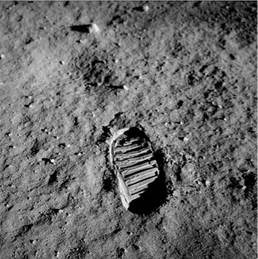Preface
|
|
Courtesy of NASA
Sunday, July 20, 1969. 4:10 pm EDT.
For readers of a certain age, this is a date and time that can never be forgotten. A moment in time in which everyone remembers where they were, and what they were doing. And unlike other dates that live in infamy, such as December 7 or 9/11,
this is a moment of history that brings awe, inspiration, and pride. For this was the day that Neil Armstrong and Buzz Aldrin landed the LM Eagle on the Moon.
Decades later, generations of people look to the Moon, and know that mankind has been there. But many have no idea where the landings occurred. The Moon has been visited by both robotic and human visitors, with landing sites scattered across its surface. It is the goal of this book to enlighten the reader, and show where to look upon the Moon for mankind’s landing sites.
As a child of the Sixties, I grew up entranced by the burgeoning Space Age. I received as a Christmas present my first telescope at the age of eleven, and my first target was to view the Moon. It was thrilling. I grew up to become a professional engineer, spending most of my career in the field of aviation. But my love for telescopes and astronomy never waned. Since my retirement, I have devoted a great deal of time supporting local Washington D. C. telescope stores and giving lectures on telescopes and astronomy equipment to astronomy clubs in Maryland and northern Virginia. And for those of sharp memories and a stack of old astronomy magazines in their basements, you’ll find an article written by yours truly in the November, 1989 issue of Astronomy magazine on the subject of building a Dobsonian telescope.
Now that I am retired from my professional engineering life, I’ve found that I can spend more time viewing the skies through my telescopes. (Yes, that is plural. I’m afraid I’m slightly on the lunatic fringe of the hobby, pun intended.) Photos from NASA’s Lunar Reconnaissance Orbiter, showing the Apollo landing sites from an altitude of 50 miles, inspired me to search for the lander locations using my telescopes. And, with a subtle nudge from my older son Adam is the inspiration for this book.
The intent of this book is twofold: to serve as a visual guide, stepping the reader through a process for locating and viewing the Apollo landing sites, and an appreciation of what was accomplished there. The reader should look elsewhere for a more historical accounting of the Apollo Program, as there are many fabulous books on the subject written by former Apollo astronauts, Apollo flight controllers, engineers, and other well-known authors. There is a conscious informality that I’ve used in referring to the astronauts and their missions and equipment. This book serves as an observational guide, allowing the casual and serious observer a chance to locate the Apollo landing sites visually (with or without visual aid), and appreciate the historic experiments and equipment left behind. A review of the scientific results is included, and interestingly enough new knowledge is being added about the Moon from Apollo data to this day!
Also included are photos from the lunar probes leading up to Apollo. The long – forgotten Ranger series and the Surveyor series of lunar probes provided valuable information to NASA, both in terms of science and in terms of engineering requirements and techniques needed to getting to the Moon.
Maybe someday in the future, Mankind can reach out to the Moon again. And provide a reason for a Volume 2 to this book.
![]() Gore, VA January 25, 2014
Gore, VA January 25, 2014











